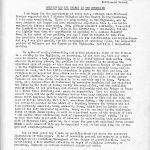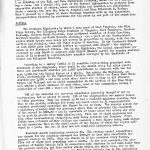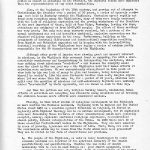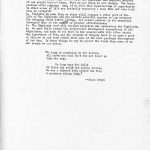Pine Mountain Settlement School
Series 04: ADMINISTRATION – Directors
Series 34: RELIGION
Glyn Morris TALKS 1931-1977
Religion in the Mountains
For: General Faculty at Columbia University,
New York, January 17, 1941
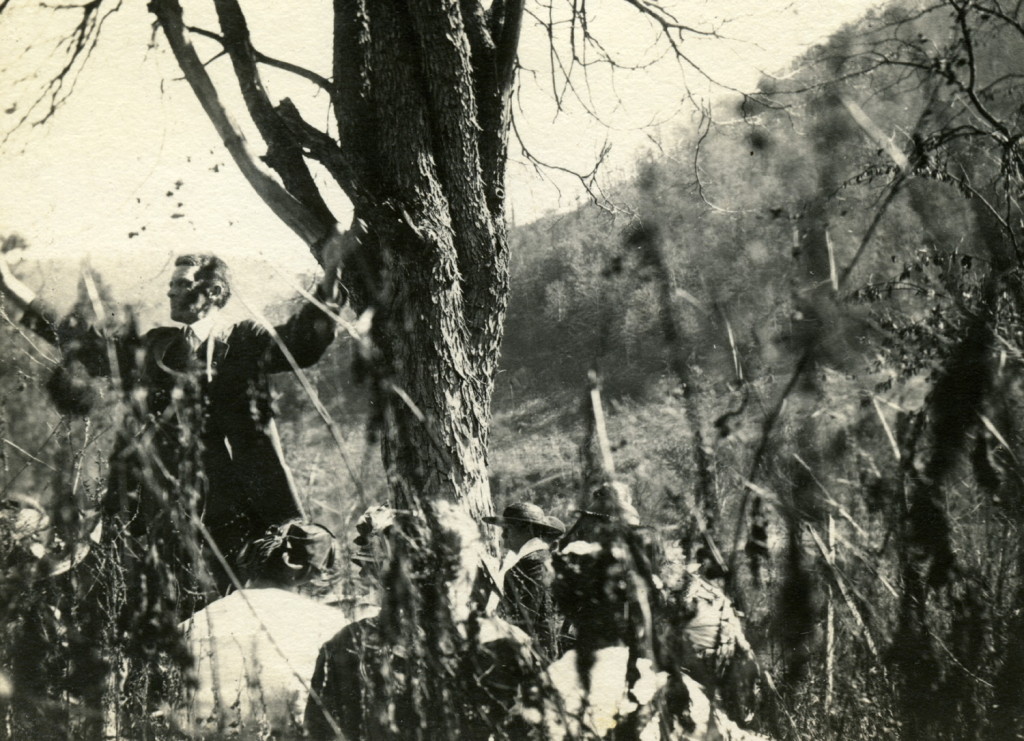
A preacher at a “funeralizing” at Big Laurel, near the Medical Settlement, c. 1920s. [X_099_workers_2524c_mod.jpg]
TAGS: Glyn Morris, Religion in the Mountains, Funeralizing, preaching, Pine Mountain Settlement School, religion, Holiness Church, Baptist, Episcopalian, Presbyterian, Catholic, Appalachian students, education, literacy
GLYN MORRIS 1941 Religion in the Mountains
The following lecture on religion and education, given to the General Faculty at Columbia University, New York, on January 17, 1941, at the request of Orie Latham Hatcher, is one of Glyn Morris’s most thoughtful statements regarding his faith and its relation to his work at Pine Mountain. In his lecture, he addresses his understanding of the various faiths he encountered as an educator at the Pine Mountain Settlement School. His exploration of religious beliefs was a lifetime journey, and the great variety of beliefs he encountered at Pine Mountain seemed to sit at the nexus of his spiritual and professional self.
Morris came to Pine Mountain Settlement School to assume the role of Director at the age of 26 in 1931. He stayed at the school for ten years, until 1941, when he enlisted as a Chaplin in the Army during WWII. Following the war, he returned to Kentucky to work with the Harlan County School System at Evarts. There, he continued his exploration of educational reform and his religious beliefs and how those beliefs could inform educational agendas and community development.
In Evarts he continued his work with the Rural Youth Guidance Program, an inclusive and experimental educational approach developed by, Orie Latham Hatcher, Ruth Strang, and James Cawood, the Superintendent of Schools in Harlan County. The waters of his deep religious belief system and the Progressive educational ideas that he pulled from John Dewey became a fundamental reservoir for his later life. The lessons he learned in shaping the Rural Youth Guidance programs at Pine Mountain and at Everts can be unfolded in all his later educational work. Eastern Kentucky and Pine Mountain are fortunate to have such a deep resource of his educational talents. His writing, his talks, his broad experience enriched the lives of many. The many are now a multitude and they continue to pass on his legacy and his wisdom.
THE TALK
In the opening remarks of his 1941 talk, “Religion in the Mountains”, he cites Columbia University educator Orie Latham Hatcher as the source of his inspiration for the topic, noting that Dr. Hatcher encouraged him to speak about religion in the mountains of the Appalachians. His response to her nudge is a deeply thoughtful and intensely researched. He offers his ideas regarding religion in the Appalachians and particularly in the Central Appalachians. Religion was not an easy or fully formed topic for Morris, and it is not surprising to find him still searching for his religious perspective within the talk.
DR. HATCHER AND THE GUIDANCE INSTITUTES
Dr. Hatcher, his muse when developing the Institute for Rural Youth Guidance in Harlan County, was, like Morris, fiercely independent. But when religion was under discussion, she apparently found Morris’s deeply held views to be balanced and keenly observant of national trends, and views that resonated with her own religious perspectives. His non-sectarian approach to religion opened dialogues across multiple sectarian silos. Somehow, Morris always aimed at and arrived at a comfortable intellectual consensus in his presentation of a world of multiple religions and varieties of educational methodology.
Hatcher’s stewardship of the development of the series of Rural Youth Guidance Institutes was a respectful and magical relationship for both educators. The Institutes became one of the most innovative educational programs for rural Appalachian youth in Harlan County and caught the attention of national educational circles. Perhaps this was because at the core of the approach was the respect for the student’s independent soul. To understand the soul, according to Morris, was to understand the religion of the Central Appalachians and to perhaps open the student to learning and instructors to educating.
To understand the religion of the student was to find the path to learning for many of the youth at the Settlement School. Through his administrative and educational lessons learned from Pine Mountain students, Morris went on to develop some remarkable educational innovations. In his autobiography, Less Traveled Roads (1977), Morris says of the Institute’s purpose that it was
..to increase our efficiency in helping Harlan County youth to find themselves: by surveying their needs and all possible resources for meeting those needs; by coordinating these resources in a concerted effort to accomplish the above objective … [–28-page Youth Guidance Institute booklet] …
To find themselves, Morris asked each student to reach deep into their soul. This self-reflection was quite different from the early years when the student population was much younger. This more mature reflective process, encouraged by Morris, was often accomplished in dialogue with the student or through a guidance program that integrated religious beliefs into the educational progress. By exploring students as a disparate group, Morris built circles of trust. Part of the 1940 “youth round table” was focused on exploring differences. Morris was able to bring together for the first time Black, Brown, and White students in soul-searching dialogues on a multitude of topics, including religion. It was one of — if not the first — attempt to integrate the schools of Harlan county, and it was highly successful, due in part to the shared religious perspectives of disparate local churches.
Morris explains in his book, A Road Less Traveled (1977), that approximately 10% of the students in Harlan County in the mid-1940s were African American children of coal miners. The process of joining Black and White students was the first time that an integrated program had been tried in the county. Morris relates that of that first joint program, the integration was “revealing and instructive.” What he saw and reported was that “integration is not a youth problem, it is an adult problem.” In many ways, this exercise in cross-cultural dynamics is the underlying message that runs throughout this lecture of Morris — “Religion in the Mountains.”
(RELATED: See November NOTES 1935, pages 1-6, for a lengthy treatise on local religion by Alice Cobb.)
TRANSCRIPTION: Religion in the Mountains
Page 1
Presented to General Faculty [Columbia University, New York]
January 17, 1941
Glyn Morris
Director of Pine Mountain Settlement School
RELIGION AND THE CHURCH IN THE MOUNTAINS
Page 1
I am happy for the opportunity of being here, although when Professor Hatcher suggested that I discuss Religion and the Church in the mountains, I felt some trepidation. There are many working in the Highlands who, by more intimate and longer and more widespread experience than I, are better equipped to discuss this topic. But, perhaps somewhat selfishly, I accepted the invitation to come, for I felt in the invitation a challenge; for who can lightly turn down the opportunity of speaking to a college faculty? Even in the midst of our problem, you and I find it helpful to turn from the immediate task for a longer view with all its relationships and implications. And so, I was glad myself, for the assignment of examining, again, the many-sided problem of religion and the church in the Highlands, and it is a many-sided problem.
In spite of radio, automobile, and motion pictures, faith of the fathers is a reality in the Highlands, as consuming, if not more so, than any other area in America, but, paradoxically, it is a faith without much works. And, whereas in so many places, the problem (of the church) is to sharpen the spiritual eyes of people so that they may see the unseen things of the spirit – in the Highlands, the unseen things are sometimes too sharply seen, and are[?] become so real, that too little attention is given to the here and now, and religion is so separated from ethics as to make it possible for a man who has just shot another to pray for his departed soul at the site of the murder because no one else feels inclined to do so and this must be done, furthermore, in a region often characterized by excessive homicide and law violation the Bible is the Book of books; verily the word of God, and the infallible rule of faith, if not practice; and eternal fellowship with the Prince of Peace is a theme taken literally and sworn to repeatedly.
Here are people who cannot read, but who quote scripture better than many seminary graduates; whose faith inspires them to handle poisonous snakes or fire and who take the word of God so literally that I have seen them during a dry season move from one stream to another in the midst of a baptism, because the brother who had been partially immersed, being unusually large, might have as little as one inch of his body uncovered by water. Here, on the one hand, is the child-like faith of which Jesus spoke, as well as a profound sense of the tragedy of life, and on the other, a distressing lack of appreciation of Jesus’ ethic. It is my hope that this paper will be of some use in understanding this paradoxical part of Highland life, which is, in a sense, the greatest spiritual force around which a more abundant life may be organized – and at the same time one of the greatest stumbling-blocks.
And at this point, may I make my qualifications and state the necessary limitations of this paper? It is of necessity general and summary in nature, although we are conscious throughout of the danger of generalization. And, in generalizing, I have omitted attention to types of religious services, [and] of preaching, [and] emphasis on various doctrinal points and music.
By the mountains, I mean the entire Appalachian area, with its six distinct areas within this region, each with its peculiar geological, topographical, social, and economic characteristics. However, for the most part, I am conscious not of broad fertile valleys, nor of prosperous towns and cities, but rather of
Page 2
coves and hollows and lonely places; coal camps and all those spots which yet form the area where special needs are our reason for being here. And particularly I am thinking of the N.E. and N.W. Cumberland Plateaus, which are in a special way — ours. And I should add, most of the factual information is gathered from exhaustive studies of others, whose scholarship and devotion are established facts — namely, the late Mr. John C. Campbell and Miss Elizabeth R. Hooker. What I present is a digest of their findings together with my own subjective interpretation flavored by residence for ten years in one part of the mountains.
FACTUAL
The Southern Highlands by which I mean most of West Virginia the Blue Ridge Valley the Allegheny Ridge counties of Virginia, east Tennessee, eastern Kentucky, western North Carolina, far northwest counties of South Carolina, northern Georgia, and northeastern Alabama our part of the southeastern region which spends more money per person in proportion to income both for EDUCATION dictate and religion, than any other region of America in the South. $16.02 of each $1000 goes into church coffers as compared to $10.68, the highest twitches for the NE (Odom), but in the Highlands, the annual expenditure per resident is only $4.80 as compared with $10.35 (Odom, page 178) for country churches alone of 21 nationally representative counties surveyed by the Institute of Social and Religious Research.
According to a survey in 1931 of 17 counties representing principal subdivisions of the Highlands, there would be one church every 2.3 miles apart. 3 1/4 churches per 1000 inhabitants, as compared with two for each 1000 for the United States as a whole. But within the Highlands our areas particularly in the Cumberland Plateau where there are fewer than three churches per 1000 and some areas where there is as many as 4.2 Central Ridge in valleys and some areas where there are as many as 4.2 central ridges and valleys and in eight communities in the section of the Blue Ridge area within a short distance of each other none of the communities having a population of over 500 there are 20 churches.
70% of the churches are one room structures generally thought of not as sanctuaries but as places to meet 11% of the congregation used school houses or other quarters only one church in 50 had a resonant minister devoting full time to his parish although for towns and rural areas in 21 representative counties previously mentioned the figure is one in four the average salary for a minister allowing $200 for parsonage where this is provided in 1/5 of the cases is 623 dollars and eighty-three cents and in 1/6 of those cases the salary was made up in part by grants from home missions aid. Five out of the eight ministers and some other breadwinning occupations, many being laborers and farmers, 4/5 have attended neither college nor seminary. This figure, being much higher in the mountains than in the rural areas of the states of which the region surveyed is a part, two out of five had not completed elementary school.
Resident church membership averages 58, and the average annual expenditure per church for the two counties surveyed was $280.37 or less than one-fourth the general average in 1920. Only one church in 13 has services every Sunday, and five out of the eight have preaching once a month. In the areas surveyed, the proportion of Sunday schools held in connection with churches is not much lower than the general average, but this varies widely within the whole area, for on the North-East Cumberland Plateau, there are few Sunday schools due to the opposition of the primitive churches. Less than 1/6 of the churches had a woman’s …
Page 3.
… society, and a little over one-fifth had a young people’s society. Although until 1926 there was a gradual rise in church membership in proportion to population, 30.4 in 1906 to 36.7 in 1925, a trend corresponding to the national ratio — the ratio for the Highlands, 36.7, is still considerably below the national rural average, 47.8 (#205 p.179). Again, the figures are lowest on the Northeast Cumberland Plateau. (17.3) — and the ratios within the entire area varied from 7.1 to 68.2%.
Scattered through their Highlands are 98 denominations, including at least seven kinds of Baptists with such varied headings as: United, Regular, Separate, Too-good-in-the-Spirit, Pencil, Slab, Enterprise, Forty-gallon, Free-will, Duck River, nine kinds of Methodists; seven Presbyterian. One-half of the churches are of the Congregational Polity type. Two-fifths of all church members are Baptists, and Methodists rank next with one-third of the churches and three-tenths of the members.
Again. It must be remembered that those figures are all averages. Though the various distinct areas. Appalachian plateau, and period E. and and period W., blue Ridge, central Ridge, and valleys. Python have much in common, They include, on the one hand, the comparative prosperous central ridges. And valleys., with a population of 1000. 1,170,000 your economic conditions are good. You’re correspondingly more and better churches, the strong centralized denomination. Influence and on the other hand, the Northeast Cumberland Plateau with a population of right hunting. In 28,000. With extreme isolation, quite common, low income, corresponding to fewer and poorer churches, fewer. Fewer church members, and a proportionately large number of congregations of a primitive kind.
These are the bare facts, but they tell us much. Now, let us look at the background of these facts — for today is the product of yesterday — and a glance at the past gives us at once both more sympathy for practices which at first drew only curiosity and a sense of the religious poverty which has befallen the Highlander when compared with his former religious heritage. Disconcerting as the 100 sects may be, they represent the spirit of seeking after truth — even at the expense of Christian unity and love — a spirit which once was good, but which is inorganic now and is therefore in cold storage. It is an expression, now on a tangent, of a pioneering spirit which crossed a great ocean in search, among other things, of religious freedom. In the hollows and coves, shut off from the larger currents of events, a great tradition of discussion has become hair-splitting, doctrinal bickering; and independence of conscience has grown into a dangerous detachment from, and even opposition to, progress. (I use this word advisedly)
The English, Scotch-Irish, Germans, and Huguenots into the Highlands had one thing in common, mainly, that religion was of vital importance. Generations of intolerance and persecution had pitted them against the Roman Catholic Church and all it represented. They believed in the Bible as the literal word of God, and they were individualists.
The English, who, before coming into the Highlands, and for the most part, lived for several generations in other parts of America, most were Puritans and independents. They had a tradition of independence of thought and action dating back, in this particular sense, to the rise of the Lollards in the 14th …
Page 4.
… century. Through the leadership of Wyclif, they had learned to question the magical power of the Catholic ritual, and such breaking away from tradition had its effect on the whole point of view of the poor, among whom this dissension found sympathy. They learned to worship away from the church building. Persecution and individual thinking developed in them greater resolution and courage, dignity, persistence, and a belief in the rights of the individual. They were ambitious — and inclined to take the other side of any issue.
The Scotch-Irish, who came later, brought with them a tradition of having defended their faith in Scotland, sought refuge in Ireland, and then, because of ambition and a desire for further religious freedom, as well as to escape from the economic handicaps of Ireland, moved on to America. Theirs was the Presbyterian faith with its sternness and emphasis on predestination. They were serious and hardworking, as well as emotional and imaginative. With this group came a considerable number of ministers.
The Germans and others from Central Europe, who settled largely from Pennsylvania, Virginia, down through the valley to Roanoke, and who are considered by Tidewater Virginians not to be Virginians, brought with them memories of war and destruction out of religious differences, which bred in them characteristics not unlike those of the English and Scotch-Irish. To those three distinct groups, “religion was of vital importance for which they would make almost any sacrifice.” (Hooker)
As migration of Germans and Scotch Irish down the valley decreased, migration into the Highlands of people from Eastern Virginia and North Carolina, in particular, increased. Ex- soldiers, small farmers, younger sons of good families, as well as men who had failed elsewhere — those for whom easy living and good hunting were enough— and even some rogues who “shunned the restrictions of more organized society”, found their way into the highways, first into the broader valleys, then after some decades, because of the pressure of population, back into the hollows and branches.
Although from the beginning, serious and devoted attempts were made to start churches, and a surprising number were started very early in the history of island occupation, for the most part, people were so scattered that churches were few and far between them, as is easily understood. The structure of such churches as they were reflected the life of the frontier. They were one-room log masterpieces of uncomfortable nonconformity. Here was blended the naturally fatalistic ideas of the settler whose individualism had been sharpened by the second process of selectivity, and to whom the perils of the frontier had brought greater fatalism and pessimism. Religious services were among the few events to break the monotony of his existence. Centralized denominational control was impossible, and the responsibility for conducting religious services fell upon anyone who felt the call, regardless of his preparation.
At about the time when the Highlands were being settled, both Baptist and Methodist denominations spread from Europe and increased rapidly in influence in America, were fused into the life of the Highlands — which proved to be fertile ground. Both the predestination of the Baptist preachers, many of whom came to Kentucky from both cold and hot receptions in Eastern Virginia, and the equality of all men as regards salvation, as proclaimed by the Methodists, appealed to the people of the frontier. Baptist theology, which by the time it reached the frontier had increased in emotional intensity, with its emphasis on …
Page 5
… immersion, as found in the New Testament, appealed to the Highlanders, and with their polity of control of church affairs in the hands of the local congregation as almost an essential on the frontier, the Baptists became more numerous than the representatives of any other denomination.
Also, at the beginning of the 19th century, and growing out of attempts to Christianize the frontier over a period of 30 years, a series of open-air revivals were held in Kentucky. outside the Highlands. Contagion spread rapidly and found warm reception among the Highlanders, many of whom were deeply concerned with the lack of religious expression and the growing wickedness of the frontier. At the most important of those, held at Cane Ridge, KY, lasting six days, attendance was estimated at from 10 – 25,1000 people. The effect of those Meetings was very great. Not only were many converts received, but a pattern of abnormal excitement was set, and hereafter, emotional, explosive conversion was the standard religious experience in the area. Furthermore, building on the groundwork of doctrinal differences in denominational competition resulting from Baptist and Methodist expansion, and in keeping with the hair-splitting doctrinal searching of the Highlanders, here begins a series of schisms partly responsible for the 98 denominations now in the Highlands.
Although other parts of America were showing great and unusual interest in missions, in the Highlands, this movement found no sympathy, for a characteristic consistency and inconsistency in interpreting the scripture, which says nothing about missionary “societies”, — and because the Almighty would save the elect in His own good way — the Highlander held that human efforts at salvation were useless. He was unconsciously strengthened in this point of view, both by his own lack of money to give and because, being hard pressed himself, he couldn’t, like his more fortunate brother down east, imagine anyone whose lot was worse than his own. So for a period of 25 years, churches were split over the question of missions, and anti-missionary Baptists were unkindly dubbed ” hard shells” by their opponents, and are known as such to this day.
And thus the pattern was set, religion turning inward, minimizing human efforts at salvation, and accepting low standards among ministers and no training for children because man’s efforts were considered useless.
Finally, in this brief sketch of religious development in the Highlands we must mention the Holiness movement. Beginning both in England and the United States about 1870 as a reaction against formalism in religion, it fitted in logically with Highland theology and is an extreme development, for it emphasized even more forcefully those features of other denominations which were generally accepted, namely, explosive emotional religious experience, decentralized church polity, literal interpretation of the Bible. In 1926, there were 15 of those so-called Perfectionist bodies in the Highlands. They are more numerous in areas of poverty., IGN. In the dullness of life. What, then, are some of the conclusions that may be drawn from the facts? Which have been presented? They can be stated in the form of observations and problems.
- The people of the Highlands, as well as being handicapped by acute economic problems, are deprived of the spiritual ministry of the Church, quantitatively and qualitatively. Besides the low ratio of church membership, this is seen in such things as: poor church equipment, below average quality when training a Ministry, lack of appreciation of the sacraments, and the fact that marriages, for the most part, are performed by …
Page 6
… civic officials, and communion is rarely administered.
2. There is a correlation between poverty, isolation, and the number of so-called primitive churches. Particularly is this seen on the Northeast Cumberland Plateau.
3. The theology of the Highlander, sharpened by generations of economic deficiency and cultural lag, concerned as it is with “eternal issues rather than temporal problems, “has, with a consistency that would startle even John Calvin, led to a fatal stagnation which expresses itself in the following ways:
(a) The Highlander is not overly concerned with improving his environment. He takes the “What’s the use?” attitude.
(b) He is inclined to be apathetic and even uncooperative in regard to education.
(c) Believing that physical handicaps are the will of God, he makes more difficult the conquest of disease. This is not as general as in times past, but is still known.
It should be said that these problems vary in intensity and, of course, do not characterize the entire area. They are found more particularly in areas where primitive churches are most prominent, particularly in the Northeastern Cumberland Plateau, where they form 27% of the total church population. Furthermore, at this point, I would like to say that the Holiess religion, transient as it may be, is a force to be reckoned with, for it comes in answer to a real need. According to Molly Clowcs, whose recent articles on the mountain appeared in The Courier Journal, a county superintendent asserted that faith, in the real sense, had gone from the mountains. “That’s the real reason we don’t go to religion for comfort anymore. We go for excitement.” This is what the Holiness religion supplies. I believe, too, that it is spreading in some sections of the mountains, and will make difficult necessary basic changes.
4. The gap between the problems of the mountains and world of which they are a part, and the point of view of the churches, is increasing. As youth, because of expansion in means of communication, are incited and stimulated, becone less stable as regrds relationship tothe home and demand more recreation because of more leisure time, the churches drew further and farther away fron this problem as well as other matters which affect welfare of youth I hold the brief, however, for most churches outside the mountains on this point. Village churches, particularly, are in a position in a small way to do something about the problem.
5. Another related problem is that of the adjustment of youth to the gap between the Bible, so narrowly interpreted by most churches that are unable to appreciate its implications and larger use, and the facts of life, particularly as derived from science in the schools and contemporary history. With increased public education and more opportunities on the college level, the gap becomes increasingly wider.
Finally, what is the challenge of this situation?
1. A doctor, having spent 40 years as a medical missionary in Africa, told me he felt that conditions in certain parts of the Highlands were worse than in Africa. The implication is that, perhaps we should be …
Page 7.
…even more concerned than we are with the spiritual and physical welfare of our people here at home. What we are doing is not enough. The basic problem still remains. And, if we feel that equalization of opportunity in other areas of life is basically necessary, does this not also hold true in religion?
2. Religion in some form or other still remains a vital part of the life of the Highlands and can provide a powerful impetus to any movement for bringing about better living. All social workers in the mountain disregard this at the expense of greater effectiveness.
3. The Highlands need well-trained ministers who understand the Highlands.
4. W must build around the deep-rooted theological conceptions of the Highlander, and seek to see that in his concern with life after death, the importance of God, and the element of tragedy that is so much a part of life, he is not very remote from some of the most profound theologians of our day. In those things, he may be nearer the truth than some of us who assume we are wiser.
end
GALLERY: Religion in the Mountains
- 01 morris_1941_relig_mtns_001
- 02 morris_1941_relig_mtns_002
- 03 morris_1941_relig_mtns_003
- 04 morris_1941_relig_mtns_004
- 05 morris_1941_relig_mtns_005
- 06 morris_1941_relig_mtns_006
- 07 morris_1941_relig_mtns_007
See Also:
GLYN MORRIS Director
RELIGION Guide
RELIGION at PMSS

